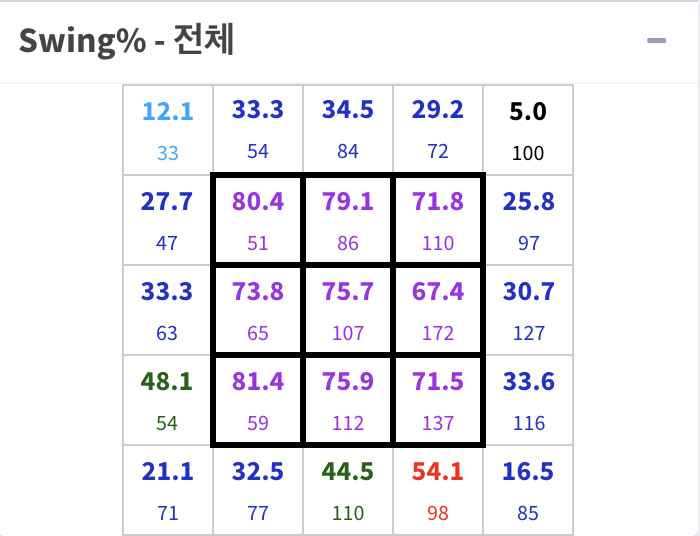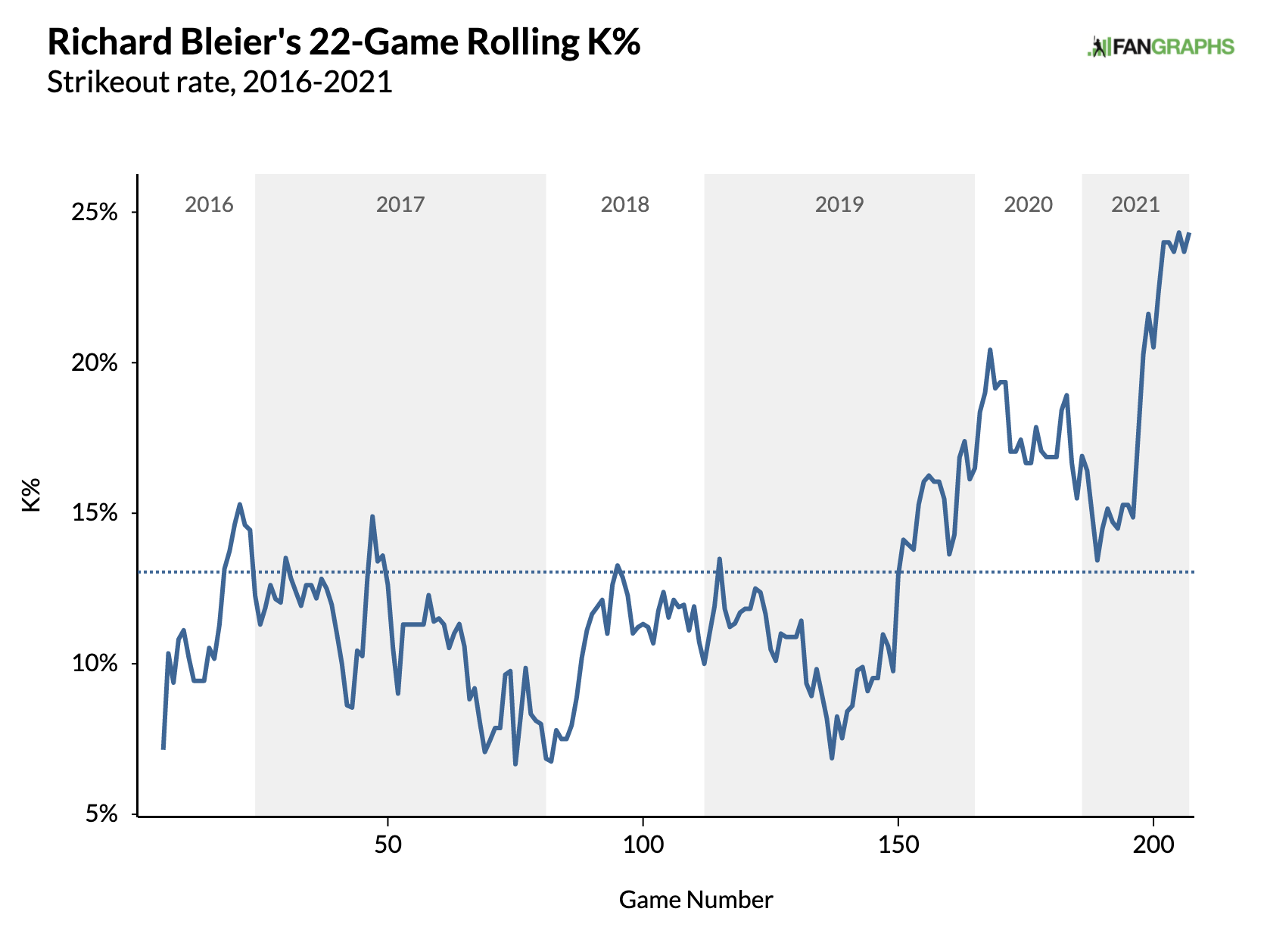There’s a New Old Book on Christian Yelich
By now, I’m sure you’re aware of Yasmani Grandal’s odd season. We’re approaching the All-Star Game, yet the veteran catcher still has an unbelievably low batting average (.177) to go along with a stellar wRC+ (131). The juxtaposition encapsulates everything useful or wrong about modern baseball, depending on whom you ask.
Regardless, it works because while Grandal does strike out a fair amount, he also walks just as often – at a league-leading rate, in fact. But enough about Grandal. This is all a set up, because really, I want to talk about Christian Yelich. Why is he relevant? Yelich is one of two hitters (min. 150 PA) this season to have both a strikeout and walk rate above 20% – you can guess who the other is. Grandal’s season is, indeed, weird. But under the radar, Yelich is showcasing the same skills necessary for one, albeit without the hideous BABIP.
Focusing on the more positive rate first, it appears that Yelich’s monstrous walk rate is thanks to an ability to lay off unattractive pitches; his chase rate this season ranks in the 98th percentile per Baseball Savant. But here’s what piqued my curiosity. The other day, I stumbled across an article in Reviewing the Brew that suggested Yelich is seeing fewer pitches in the zone since last season. While true in the aggregate, looking at 2020-21 as one chunk prevents us from unearthing a notable truth. Let’s get to the bottom of it. Below is a rolling average graph showing Yelich’s zone rate over time, beginning a couple of years ago:

Consider the roller coaster ride. Before his transformation into a destroyer of baseballs, Yelich saw an above-average rate of strikes. That rate remained stable into his 2018 MVP campaign, perhaps because pitchers were caught off-guard by his late-season tear. The following year, though, they got the memo. In response to Yelich’s newfound might, the graph illustrates how pitchers began to shy away from the zone.
So far, so sensical. What’s interesting, however, is that the downward trend continued into 2020, despite Yelich battling through an extended slump that resulted in the worst season of his career by wRC+. At the very least, he seemed to take advantage of the increasing abundance of balls. As Tony Wolfe pointed out last year, Yelich effectively turned into Joey Gallo by cutting down his swing rate from 45.2% in 2019 to 34.6% in ’20. Unfortunately, his whiff rate – even against in-zone pitches – trended in the wrong direction, pushing up both walks and strikeouts.
Now it’s 2021. As I alluded to earlier, Yelich is still a patient hitter, and his 38.2% swing rate also suggests that he’s retained most of his 2020 self. The difference? His zone rate (48.0%) has skyrocketed this season, to the point where it’s similar to that of previous years (50.8% in 2018).
More strikes, but with the same passive approach – that seems like a recipe for disaster. But as of this writing, Yelich possesses the highest walk rate of his career. He’s managed to shave off a bit of his strikeout rate, too. That’s been possible because of how pitchers have allocated their extra strikes. Here’s a plot of Yelich’s yearly zone rate since 2017 by count type (ahead, even, or behind), from which we can gain some insight:

When Yelich is ahead in the count this season, his zone rate hasn’t seen a significant increase. Maybe pitchers are reluctant to challenge him – their escape is via a surefire strike, which Yelich has crushed multiple times in his career. It’s better to nibble around the edges, I suppose. Elsewhere, though, pitchers have caught on. The strikeout totals aren’t that hideous because Yelich’s contact rates have rebounded somewhat, but they’re still a few ticks below their pre-pandemic norms.
It’s a problem. More than ever, Yelich is having a difficult time defending himself against a barrage of strikes in unfavorable situations. Sean Doolittle, seemingly aware of this, threw a fastball down the middle against Yelich for… strike three.
Look at that smirk. He knows what he did!

But besides that example, how has Yelich responded overall? Compared to 2020, his swing rates are up across all counts. That’s good when he’s behind, and not as good when he’s ahead, though it could be that he’s targeting obvious strikes. Either way, Yelich is earning his walks. Looking at the numbers, however, I began to wonder – should Yelich become even more aggressive when behind? His swing rate in those instances is up, sure. But at 39.8%, it’s still lower than the 48.2% he posted in 2018, the year when he last saw a similar rate of strikes.
Let’s try and evaluate Yelich’s swing decisions using basic game theory. Consider a showdown between him and a pitcher with the count 0-and-1. What should each player strive to accomplish? For the pitcher, the best-case scenario is reaching 0-and-2. Since the start of the Statcast era, batters have recorded a .357 wOBA on 0-and-1; with an additional strike, that number drops precipitously to .166. Missing the zone en route to 1-and-1 isn’t as bad one might think, as batters pick up just 17 points of wOBA. It’s no wonder they’re considered behind.
On the other end, Yelich’s utmost goal is to avoid reaching 0-and-2. But to swing or to take, that is the question. Swinging seems like the most logical option, but there’s a good chance Yelich will end up whiffing or fouling off the pitch. Taking a strike isn’t the end of the world, but there are also obvious balls a hitter should never go after. And what about the borderline pitches that could go either way? Hitting is hard!
Amidst a hairy situation, here’s what I did. Based on Yelich’s contact, whiff, and foul rates this season, I calculated the average value of an in-zone swing in terms of wOBA, as well as an out-of-zone swing. The value of taking a strike or ball was based on the count-based wOBAs I described earlier. With these numbers, I was able to construct a two-by-two payoff matrix, with each cell containing the wOBA loss/gain of the pitcher (left of the comma) and the batter (right of the comma) that’s dependent on the actions taken:
| Pitcher/Hitter | Swing | Take |
|---|---|---|
| Strike | -38, 38 | 191, -191 |
| Ball | 109, -109 | -17, 17 |
For example, swinging at a strike would net Yelich 38 points of wOBA and lose pitchers the same amount. The latter are offering Yelich a strike 39% of the time in 0-and-1 counts. But is this optimal? For our sake, let’s say optimization means pitchers throw strikes at a rate that makes Yelich indifferent to swinging or taking. In other words, equalizing the payoffs robs him of a preference. Do the math, and it turns out the equilibrium point for pitchers is 35.5% strikes – quite close to their actual rate.
We can also find an equilibrium point for the hitter, Yelich. This time, it’s a matter of making sure pitchers are indifferent to throwing a strike or a ball, and the math suggests Yelich needs to swing 58.6% of the time in pursuit of that goal. Sounds too high? It probably is: I sorted all 0-and-1 pitches into simple strikes or balls, but as mentioned earlier, the reality is that a fair number of balls are flat-out uncompetitive pitches. Disregard them, and Yelich’s ideal swing rate is deflated. Even if we conservatively estimate it as 50%, however, it’s still a far cry from Yelich’s actual swing rate of 39.3% in 0-and-1 counts. Small sample caveats apply – he’s seen 84 of them so far this season – but there’s potential evidence that Yelich is missing out by letting strikes pass by.
Here’s an easier way to think about this. After factoring in zone rate, Yelich is expected to lose 50 points of wOBA by swinging. Taking a pitch loses 66 points, also bad, but which one is the lesser of two evils? You certainly wouldn’t want to swing every time, but faced with these payoffs, swinging a majority of the time makes sense. The math bears out our intuition.
For fun, I repeated the process using Yelich’s ridiculous 2019 output. Ready? To neutralize Yelich, pitchers needed to throw strikes roughly 20% of the time! Nobody would have followed that advice, of course, but it goes to show how terrifying Yelich was. He crushed pitches in the zone. He crushed pitches outside the zone, too, even when behind in the count.
It’s the version of the slugger we lament the disappearance of. But all things considered, it’s been a rough two-or-so years for Yelich. His 2019 campaign came to a premature halt after a knee injury, which then segued into a truncated, strange 2020 season. Mere days into the current season, back issues sent Yelich to the Injured List, where he remained for a month. Expecting him to attack the ball with his former authority is a bit unreasonable. And arguably, Yelich’s reluctance to swing is a precaution against re-aggravating his back.
But as far as adjustments go, raising his aggression to match that of pitchers, who are adhering to both a new and old book on himself, is a simple one. As Yelich recuperates, the various components of his game are likely to come together. It’ll be interesting to observe how he and opposing pitchers adjust against each other over the course of an entire season, engaging in a dance of zero sums. How high will Yelich’s zone rate climb? At what point does he swing enough for pitchers to change course and offer more balls instead? This piece’s title suggests the book on him is fixed. In reality, it’s constantly being updated.




